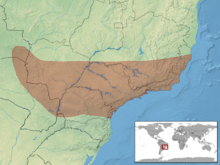Bothrops jararacussu
Bothrops jararacussu, commonly known in English as the jararacussu, is a highly venomous pit viper species endemic to South America.[1][2] It's one of the most dreaded snakes in South America and can grow up to 2,20 meters.[3]
| Bothrops jararacussu | |
|---|---|
_por_Rodrigo_Tetsuo_Argenton_(5).jpg) | |
| Scientific classification | |
| Kingdom: | Animalia |
| Phylum: | Chordata |
| Class: | Reptilia |
| Order: | Squamata |
| Suborder: | Serpentes |
| Family: | Viperidae |
| Genus: | Bothrops |
| Species: | B. jararacussu |
| Binomial name | |
| Bothrops jararacussu | |
 | |
| Synonyms[2] | |
Geographic range
It is found in South America in coastal Brazil (from Bahia to Santa Catarina), Paraguay, southeastern Bolivia, and northeastern Argentina (Misiones Province).[2]
Common names
In Brazil, Bothrops jararacussu is known by many common names, among which are the following: jararacuçu, jararacuçu-verdadeiro, patrona, surucucu, surucucu-dourada, surucucu-tapete, urutu-dourado, and urutu-estrela.[4]
Venom
Like all other species in the genus Bothrops, the jararacussu has rather potent venom, potent enough to kill sixteen people. The venom is citotoxic, hemotoxic and myotoxic, symptoms of the bite include, intense local pain, edema, necrosis, blurred Vision, shock and systemic hemorrhage. Cerebral hemorrhage, kidney failure and coagulopathy have already been reported.[5] The LD50 value is 0.14 mg/kg (intravenous injection), 4.92 mg/kg (subcutaneous injection) and 2.73 mg/kg (intraperitoneal injection), while the venom yield is 1000 mg.[6]
References
- Scott, N.; Pelegrin, N.; Montero, R.; Kacoliris, F.; Carreira, S.; Cacciali, P. & Giraudo, A. (2019). "Bothrops jararacussu". IUCN Red List of Threatened Species. 2019: e.T178720A55929242. doi:10.2305/IUCN.UK.2019-2.RLTS.T178720A55929242.en. Retrieved 10 January 2020.
- Bothrops jararacussu at the Reptarium.cz Reptile Database. Accessed 28 April 2020.
- Milani Júnior, R; Jorge, MT; de Campos, FP; Martins, FP; Bousso, A; Cardoso, JL; Ribeiro, LA; Fan, HW; França, FO; Sano-Martins, IS; Cardoso, D; Ide Fernandez, C; Fernandes, JC; Aldred, VL; Sandoval, MP; Puorto, G; Theakston, RD & Warrell, DA (May 1997). "Snake bites by the jararacuçu (Bothrops jararacussu): clinicopathological studies of 29 proven cases in São Paulo State, Brazil". QJM: An International Journal of Medicine. 90 (5): 323–334. doi:10.1093/qjmed/90.5.323. PMID 9205667.
- Ferreira, A.B.H. 1986. Novo Dicionário da Língua Portuguesa: Segunda Edição. Nova Fronteira. Rio de Janeiro. p. 984.
- Pinho, FM & Burdmann, EA (March 2001). "Fatal cerebral hemorrhage and acute renal failure after young Bothrops jararacussu snake bite". Renal Failure. 23 (2): 269–77. doi:10.1081/jdi-100103499. PMID 11417959.
- "LD50 and venom yields | snakedatabase.org". snakedatabase.org. Retrieved 2020-03-12.
Further reading
- Lacerda, J.P. 1884. Leçons sur le venin des serpents du Brésil et sur la méthode de traitement des morsures venimeuses par le permanganate de potasse. Lombaerts & C. Rio de Janeiro. 194 pp. (Bothrops jararacussu, p. 8.)
